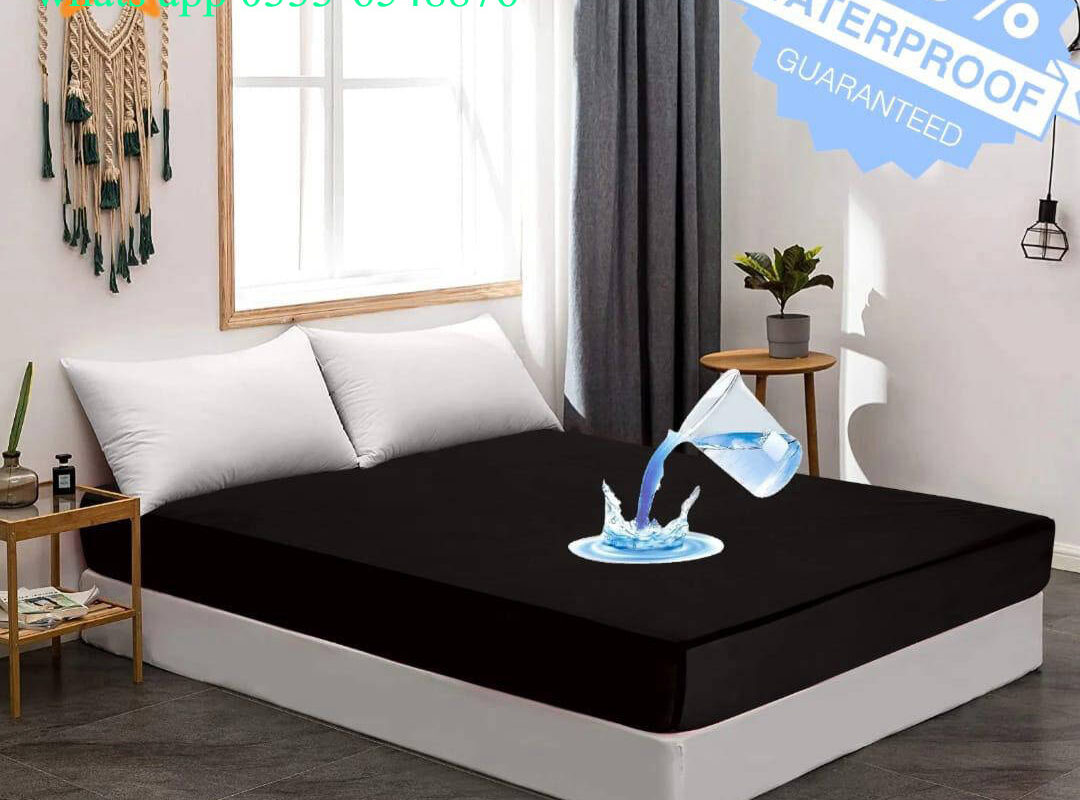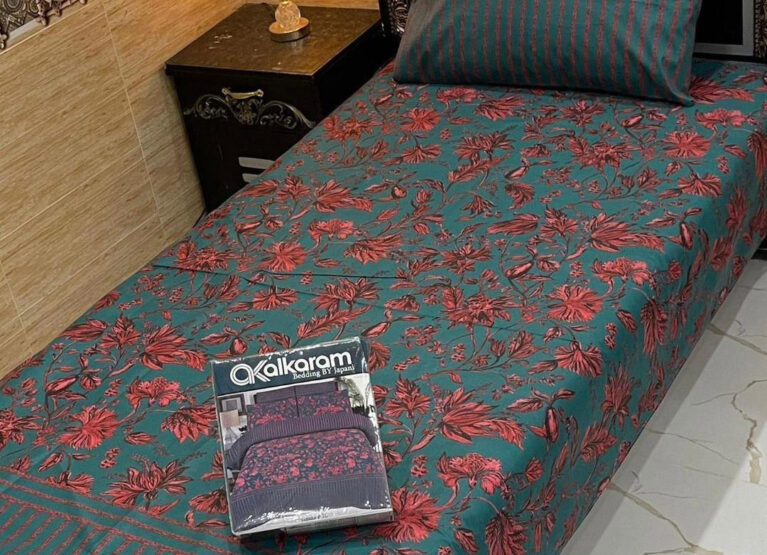1. Understanding the Role of a Mattress Protector
A mattress protector is more than just cover your bed. It guards against spills, stains, dust mites, allergens, sweat, and accidents. Without a mattress cover, your mattress absorbs moisture and dirt that can shorten its life. Moreover a good mattress protector preserves hygiene and comfort.
When I first bought a latex mattress, I didn’t use a protector. Within weeks, sweat and stains had left visible marks. This taught me that even a best mattress material also needs a reliable protector. So, whether you have a latex or have memory foam mattress, protector matters just as much.
2. Types of Bedding Protection: Key Options
Here are major kinds you’ll encounter:
Double bed mattress protector: Sized for double beds, this protector must fully cover the mattress edges without slipping.
Fitted mattress protector: Elastic edges wrap around like a fitted sheet; they stay tight even if you move a lot in your sleep.
Full mattress cover: Covers the entire mattress, sometimes with zippered enclosure. It gives full barrier protection.
Waterproof mattress protector / waterproof mattress cover: Shields against liquids while allowing breath ability in many designs.
Cotton mattress protector: Made of natural fibers; breathable, gentle on skin, often washable also.
Plastic mattress protector: Inexpensive, very waterproof but less breathable and noisier.
Latex mattress protector: Less common; could refer to protector used with latex mattresses or protector made of latex material.
Anti allergy mattress protector: Designed to block allergens, dust mites, mold crucial for sensitive sleepers.
Each type additionally has its strengths and trade offs. What makes one best also depends on your priorities: protection, comfort, longevity, allergy control, or ease of cleaning.
3. Key Features That Make a Mattress Protector Best
To judge what makes a mattress protector best, check for these features. I list what matters most especially from personal experience.
3.1 Waterproofing without Sacrificing Comfort
You want a protector that blocks water but still lets your skin breathe. Waterproof mattress protectors built with thin polyurethane layers do this well. They repel liquids yet feel quiet. In contrast, cheap plastic mattress covers often crackle and trap heat. When I slept under a plastic like vinyl protector once, I woke sweaty and hot. After switching to waterproof cover with PU membrane, sleep improved immediately.
3.2 Allergens and Anti Allergy Protection
The best mattress protector should also guard against dust mites, pollen, mold, pet dander. In addition if you suffer allergies, look for anti allergy mattress protector with a tightly woven fabric (chirpy thread count) or encasement design. Full mattress covers with zipper closures help stop allergens entering or exiting.
From my experience, zipper encasement is worth the slight extra cost. An allergenic attack I had faded after bringing home one that sealed fully. So for allergy prone folks, don’t skip this feature.
3.3 Fit and Secure Design
Even the best materials fail if the protector slips off. Moreover double bed mattress protector must match your mattress depth and size. Fitted mattress protector designs with elastic edges often hold better than flat sheet types. Full mattress cover/encasement style gives full wrap around protection.
I once used a standard fitted protector on a deep pillow top mattress it kept popping off. Then I got one labeled “deep pocket fitted mattress protector,” and problem solved. So always measure mattress depth and buy accordingly.
3.4 Material & Feel
You’ll almost sleep on this protector every night, so texture matters. Cotton mattress protector is soft, breathable, and usually quiet. Polyester blends can be durable but might feel less natural. Plastic mattress (vinyl or PU) is waterproof but noisy and less comfy. Latex mattress protector is less typical but may add cushioning or elasticity.
I prefer cotton blends with waterproof layer. They offer good softness and keep me cool. But latex mattress protectors are great if you want more bounce or if your main mattress is latex and you want matching feel.
3.5 Durability & Wash ability
Best mattress protectors also withstand many washes without degrading. Look for protectors that resist shrinking, maintain waterproofing, and keep seams intact. Wash in cold or warm water, avoid high heat. Also check drying instructions some need air dry, others low tumble.
My protector with pure cotton top began shrinking after only two hot washes. Since then, I’ve stuck with protectors that clearly label care instructions and fiber content. It makes a big difference over years.
4. How Materials Differ: Pros & Cons
To decide what makes a mattress protector best for you, it’s also bery important to understand the materials used. Different fabrics offer different benefits and drawbacks, and knowing these can help you make a smarter choice.
Cotton is one of the most popular materials. It’s soft, breathable, and has a natural feel, which makes it great for sensitive skin. However, it can wrinkle easily and isn’t naturally waterproof unless treated. It may also shrink in the wash if not cared for properly.
Polyurethane (PU) membrane is often used in waterproof mattress protectors. It’s both waterproof and breathable, and it stays quiet during sleep, unlike some plastic-based options. The downside is that it can be more expensive and may lose some of its waterproofing after many washes.
Vinyl or PVC, often referred to as plastic mattress covers, are very cheap and offer total waterproof protection. But they come with some serious trade offs they’re noisy, trap heat, and often have a strong chemical smell. They’re also not comfortable for long term use.
Latex, whether natural or synthetic, adds a layer of cushioning and is naturally resistant to mold and dust mites. It’s a resilient material, but it comes at a higher cost. It’s also heavier and could trigger allergies in people sensitive to latex.
Blended fabrics combine different materials to balance cost, durability, and softness. However, the mix might mean you lose a bit of breath ability or comfort depending on the blend.
5. Which Style Suits Your Sleep and Needs?
Here I compare style‑types by use case. I share what worked for me, so you can decide what makes a mattress protector best “for you”.
5.1 Best for Couples & Hot Sleepers
If one or both partners run hot, go for breathable materials cotton or cotton PU blends, not plastic mattresses. In addition fitted mattress protector with breathable top layer plus waterproof core works well. Also, ensure protector is snug so heat doesn’t get trapped in loose fabric.
My friend and I share a full mattress; when I tried a cheap plastic cover, we felt like we were in a sauna. Switching to a waterproof cover with cotton top changed that cooler, more comfortable.
5.2 Best for Kids, Pets, or Accidents
Here waterproof mattress cover with full encasement helps. Or double bed mattress protector that fully covers if child shares bed. Easy wash ability and strong waterproofing are must.
We also used mattress protectors under our guest room bed (double size) for kids. Having a fitted waterproof protector made cleanup easy and avoided mattress odors.
5.3 Best for Allergy Sufferers
Moreover if you have asthma or allergies, choose anti allergy mattress protector with full zip cover. Allergen barrier fabric, tight weave, and wash ability at high temperatures help. Latex mattress protectors can also resist mold and dust mites.
I used a standard cover before a bout of allergies. After switching to anti allergy mattress protector, symptoms dropped almost immediately less sneezing, clearer breathing.
5.4 For Budget vs Luxury
Budget protectors also tend to be simple fitted styles, cotton or plastic, maybe without premium waterproof layers. Luxury ones also offer higher cotton thread counts, reinforced seams, full encasement, additional padding, maybe even cooling gel.
I tried one “luxury” cover for my guest bed; though it costs more, guests complimented how cool and quiet it is. So sometimes paying a bit extra gives daily comfort plus extended mattress life.
6. What Makes a Mattress Protector Best: Checklist to Use
Here is a checklist that I now use before buying. It helps me ensure I get a protector that meets all my needs.
Size match: length, width, depth (especially for double bed mattress protector).
Protective style: fitted, full cover, encasement.
Waterproof feature: membrane layered, not just coating.
Breath ability: cotton or blend fabric, not full plastic.
Allergen barrier: tight weave, zip closure, anti‑mite.
Comfort & feel: soft top, minimal noise.
Easy care: machine washable, clear cleaning instructions.
Durability: strong stitching, elastic that stays tight, waterproof property remains after washes.
Budget vs value: balance cost with features. Sometimes spending more upfront saves money later.
When I buy, I write down these points. It helps me evaluate options confidently.
7. Common Pitfalls to Avoid
To find what truly makes a mattress protector best, you must avoid certain mistakes. Here are pitfalls I wish I had known earlier.
Buying too small or shallow: Protector slipping off, exposing mattress sides. Match mattress depth.
Ignoring breath ability: Plastic covers may leak water, but often trap heat and cause sweating.
Overlooking wash care: Heat can damage waterproof layers; harsh detergents may degrade membranes.
Neglecting allergen protection: If allergy prone, flat protectors without sealing won’t stop dust mites.
Thinking all waterproof are same: There’s big quality difference between heavy vinyl layer and thin PU film because latter often performs better for regular sleep.
Avoiding those will move you much closer to owning the best mattress protector you need.
8. My Personal Advice: What I’ve Learned
Here I share lessons I gained from owning several mattress protectors over years.
I value quiet waterproofing more than flashy “premium branding.” Seems small, but noise from plastic rustling happens nightly. A waterproof mattress cover with cotton top and PU under layer trades that off perfectly.
Always measure your mattress depth. I once bought a double bed mattress protector for a standard bed that was only 8 deep. But my new mattress was 14 with pillow top. The protector looked like it didn’t even cover. Learning: match depth.
Wash protectors before first use. This helps set the waterproofing, remove factory smells, and ensure fit.
Rotate protectors occasionally. Even though they’re thin, wear tends to happen at head and foot first.
Invest in a spare protector if possible. When one is in wash, you still have protection. It saves you from expensive mattress cleaning or replacement.
9. Comparing Types: Best Choices by Scenario
Choosing the best mattress protector also often depends on your specific needs and lifestyle. Below are some common scenarios and the mattress protector styles that work best for each one.
If you’re a hot sleeper living in a humid climate, go for a fitted mattress protector with a cotton top and a waterproof membrane underneath. This combo gives you breath ability, comfort, and protection without trapping heat.
For a young child’s bed or if you’re dealing with bed wetting, a waterproof mattress cover or a full mattress cover with a zippered encasement is ideal. Moreover if it’s a shared bed like a double, make sure to get the proper size. These protectors also prevent accidents from soaking into the mattress and make cleanups much easier.
Additionally if you sleep on a latex mattress, choose a protector that matches its elasticity. A latex mattress protector or one made from a cotton and PU blend works well here. It helps maintain the natural feel and responsiveness of your latex bed.
For those with allergies or asthma, an anti allergy mattress protector is a must. Look for one with a tightly woven fabric and full encasement to block dust mites, allergens, and mold spores. This kind of barrier can significantly improve sleep quality if you’re sensitive.
If you’re working with a tight budget, a plastic mattress protector or a basic fitted waterproof style can do the job. Just make sure to pick the best quality you can afford. Even inexpensive options can offer solid protection if chosen wisely.
By matching your needs to the right style, it becomes easier to decide what makes a mattress protector best for your unique situation.
10. Conclusion: What Makes a Mattress Protector Best
So, what really makes a mattress protector best? It’s the perfect blend of protection, comfort, fit, durability, and value. A protector that:
1. Truly repels water without trapping heat
2. Fits your bed size and depth securely
3. Guards against allergens and dust mites
4. Feels soft when you lie down
5. Washes well and holds up over time
When all those features come together, you end up with a mattress protector that works every night. For me, the winning protector was a fitted waterproof mattress protector with cotton blend top, strong elastic edges, quiet PU membrane, and anti‑allergy cover. It changed my sleep, reduced worries about spills or sweating, and protected my mattress for years.
If you keep the checklist in mind, avoid common pitfalls, and choose the style that fits your specific needs, you’ll end up with the best mattress protector for you. Also, do you want me to show some top rated models (with price comparisons in Pakistan) to match your budget and needs?




